And the winner is…
Robert Flottemesch, Jen DeNike, Johanna Ballhaus, and Adrian P. De Luca
Designed for Site #3 in Abu Dhabi, on Airport Road near Masdar City.
FIRST PLACE AWARD WINNER
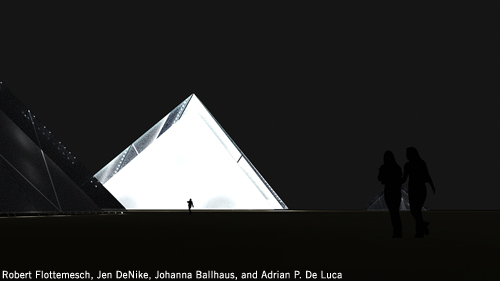
Design Submission for the 2010 Land Art Generator Initiative Design Competition
Lunar Cubit is a site specific proposal to be constructed in Abu Dhabi just outside Masdar City, the world’s first zero carbon metropolis once completed. Combining artistic vision with sustainable design and engineering, Lunar Cubit examines the nature of time through nightly contemplation of lunar phases and daily transformation of sunlight into electricity, powering up to 250 homes. Inspired by astronomy, quantum physics and the photoelectric effect, for which Einstein received the Nobel Prize in 1921, this work is open to the public, inviting a personal experience where one can literally reach out and touch a 1.74MW utility scale power plant, in the form of nine monolithic pyramids rising from the sands of Abu Dhabi.
Lunar means relating to or involving the moon and cubit is the name given to the oldest recorded units of length; employed though antiquity, the oldest cubit being the royal cubit, dating back to the Step Pyramid of Djoser circa 2,700 B.C.
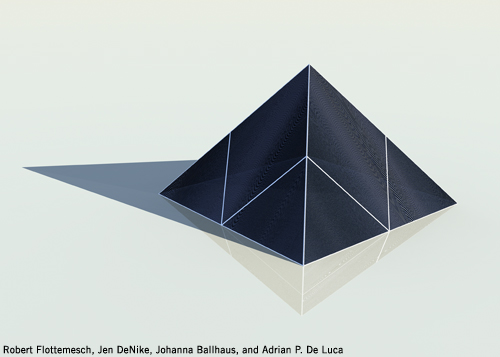
Lunar Cubit is a timekeeper, a monthly calendar, allowing viewers to measure time through the eight lunar phases represented by a ring of eight pyramids encircling one central pyramid. All nine are proportional to the Great Pyramid of Cheops in Giza and scaled using the royal cubit but they’re not made from stone; they’re made of glass and amorphous silicon, giving them the appearance of onyx polished to a mirror finish. Supported from within, the façade of the pyramids is neatly seamless, like the face of a skyscraper, crisp against the heavens, reaching from base to tip, unbroken except for two silver streaks like rays of light scribing each face into two equal triangles and one diamond. Using frameless solar panels reduces embodied energy by nearly 30%, reducing time to be energy positive from seven years to five years. Around the pyramids flow natural stone paths in a repeating pattern that mirrors buried electrical cables, conducting electrons from the outer pyramids to the central pyramid where inside they are transformed into AC energy and transmitted to the Utility Grid. Co-locating walking paths and conduit runs minimizes the footprint of disturbed land during the construction allowing the maximum amount of natural ecosystem to remain untouched.
Nine pyramids resting on tan sand; encircled by distant trees; antiquity gilded with technology. Visitors are encouraged to walk amongst these clean power plants, beacons of science, rising to meet a hail of photons from 149 million kilometers away, traveling at the speed of light, to smash into electrons, jarring them free from their molecular bonds and channeling them into electricity. Day passes; a crown of shadows slides silently across the shrubs and sand as the sun rises and falls, moving across the sky and eventually disappearing below the horizon. Two pyramids begin to glow, rising in luminosity as twilight fades and the sky grows dark. Lunar Cubit illuminates inversely proportional to the lunar cycle and tonight is a new moon; white LED’s shine through thousands of tiny bands that are the cellular structure of amorphous silicon solar panels; creating a diffused glow that rises to become a solid pyramid of white light.
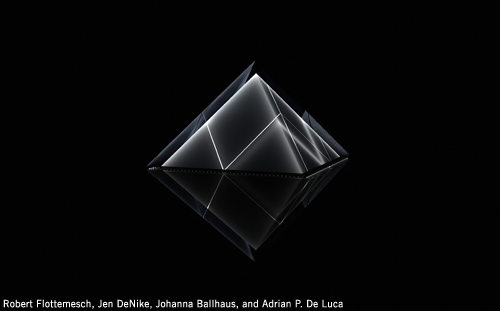
Accompanying the center pyramid is a corresponding outer pyramid, clearly marking the lunar phase like a number on the face of a clock. Inverted illumination creates a dance, an ebb and flow like the tides; pyramids of light reaching out to a hidden new moon and as the moon begins to shine, the pyramids recede, allowing moon light to fill the landscape. On the night of a full moon, only moonlight will trace a crown of silvery shadows across the desert floor until the following evening when the pyramids again begin to glow and the moon begins to fade; light forever rising and falling as the moon spins around earth, as the earth spins around the sun as the solar system spins around a massive black hole.
Located five kilometers from Abu Dhabi international airport, Lunar Cubit is visible from the air and creates a landmark, a destination for travelers to visit, relax and meditate. Nine pyramids form a ring matching near-by road structures, forming a symbol of infinity. Lunar cubit serves as a reference, a familiar sight like Big Ben or the Empire States Building, safe, comfortable and timeless as the sun and moon.
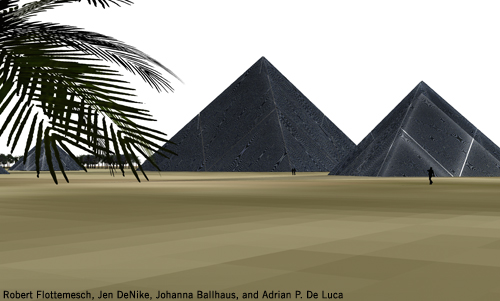
Generating electricity for 250 homes, is a perfect complement to Masdar City, a symbol of imagination and sustainability. Harnessing the power of the internet to reach a wider audience, Lunar Cubit utilizes data monitoring, connecting the system’s output and usage to a website that anyone can visit and see live information; how much energy is being generated, how much is being used by the LED lighting, what are the weather conditions and details about the site.
Follow this link for a demonstration.
Art and renewable power generation are expanding frontiers. Our world is changing and the pace of change is accelerating rapidly. Lunar Cubit is a portal between past and future, combining art and energy, welcoming us to step into the future.
Related Posts
8 Comments
Add comment Cancel reply
This site uses Akismet to reduce spam. Learn how your comment data is processed.

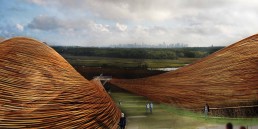
You have an extra “e” in the following sentence. It should be “by” not “bye”:
“Nine pyramids form a ring matching near-bye road structures, forming a symbol of infinity.”
Thanks! 🙂
[…] to the moon? And cubits? Here’s where things get a bit complex. The whole concept is billed as “antiquity gilded with technology,” which basically gives the artists a hall pass to go […]
[…] длины (она, к слову, составляла чуть больше 0,52 метра), — поясняют разработчики чёрных пирамид выбор их […]
[…] зафиксированная в письменности единица длины, — поясняют разработчики чёрных пирамид выбор их […]
This is an enchanting object of Art with a very sound motivation. We are facing the pure beauty…Reminds me Nam June Paik’s “Moon in the Oldest TV”, 1965 (Musée d’art moderne in Paris).
[…] between past and future, combining art and energy, welcoming us to step into the future. Source: Land Art Generator Initiative Reageer […]
[…] place: Lunar Cubit, Robert Flottemesch, Jen DeNike, Johanna Ballhaus, and Adrian P. De Luca (see image […]